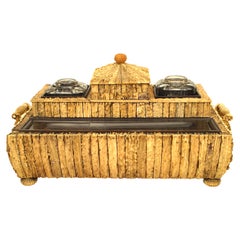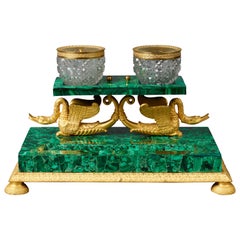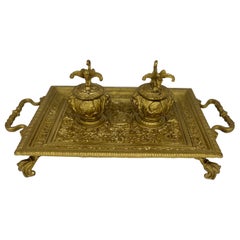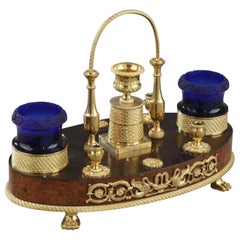Veneer Inkwells
3
to
2
1
3
3
3
1
3
Height
to
Width
to
2
2
2
1
1
1
1
1
1
1
Technique: Veneer
Anglo Indian Sandalwood and Horn Writing Box
Located in New York, NY
Anglo Indian (19th Century) antler veneered sandalwood writing box of rectangular form with 2 glass inkwells above a drawer (Vizigapatam).
Category
19th Century Anglo-Indian Antique Veneer Inkwells
Materials
Glass, Wood
Antique French Ecritoire Desk in Burled Elm, circa 1830
Located in Dallas, TX
This large and stylish 19th century French ecritoire is made of a beautiful burl elm veneer and ebonized wood with an intricate applique design to the top.
An ecritoire is typical...
Category
Early 19th Century French Antique Veneer Inkwells
Materials
Metal, Brass
Early 19th Century Russian Empire Malachite and Ormolu Inkstand Encrier Swans
Located in Worpswede / Bremen, DE
A very fine Russian giltbronze mounted malachite veneered inkstand from the first quarter of the 19th century. Of rectangular form with an acanthus leave decorated border on round fe...
Category
Early 19th Century Russian Empire Antique Veneer Inkwells
Materials
Malachite, Bronze
Related Items
Emancipation Proclamation Inkstand - 19th Century Heavily Chased Brass
Located in Atlanta, GA
Any collectors of American history should look closely at this listing.
"In the summer of 1862 President Abraham Lincoln sat at a desk in the War Department telegraph office and wit...
Category
Mid-19th Century British Rococo Antique Veneer Inkwells
Materials
Brass
Antique French Animalier Bronze Marble Greyhound Sculpture Desk Paperweight 1900
Located in Portland, OR
A very handsome antique French Animalier bronze greyhound sculpture, paperweight, circa 1900.
The bronze in the style of Emmanuel Fremiet, mad...
Category
Early 1900s French Art Nouveau Antique Veneer Inkwells
Materials
Marble, Bronze
H 3.75 in W 8 in D 3 in
French Empire Napoleon III Bizantine Bronze Ormolu Inkwell or Inkstand
Located in Miami, FL
Exquisite Bizantine French 19th century Empire Napoleon III gilded bronze inkwell.
This handcrafted antique desk accessory bears the makers mar...
Category
Late 19th Century French Empire Antique Veneer Inkwells
Materials
Bronze
Anglo Indian Amboyna Campaign Writing Box
Located in Northampton, GB
Brass Bounded
From our Writing Box collection, we are pleased to offer this Anglo Indian Amboyna Campaign Writing Box. The Writing Box of slim re...
Category
Early 19th Century Indian Campaign Antique Veneer Inkwells
Materials
Brass
Antique Inkwell, Bronze D´oré, Desk Utensil, Neogotic, circa 1850
Located in Greven, DE
Antique inkwell from gilded brass.
France, 1840-1860.
Category
Mid-19th Century French Antique Veneer Inkwells
Materials
Gold, Brass
Anglo Indian Kashmiri Wood Carved Desk Letter Stationery Rack
Located in North Hollywood, CA
Vintage Anglo-Indian Kashmir Walnut Wood Carved Desk Letter Stationery Rack.
Vintage circa 1950s Anglo-Indian Floral Wood Carving Letter Mail Organizer Holder with 4 slots.
Vintage H...
Category
Mid-20th Century Indian Anglo-Indian Veneer Inkwells
Materials
Wood
19c Anglo Indian Highly Carved Padouk and Sandalwood Sarcophagus Sewing Box
Located in Dallas, TX
PRESENTING A VERY NICE 19C Anglo Indian Highly Carved Padouk and Sandalwood Sarcophagus Sewing Box.
Made in Bombay, India circa 1890-1900.
The box case/body is made of sandalwo...
Category
Late 19th Century Indian Anglo-Indian Antique Veneer Inkwells
Materials
Bone, Padouk, Sandalwood
H 4.5 in W 12.5 in D 8.75 in
Antique Baccarat Crystal Glass Inkstand, Pen Holder, Desk Utensil, circa 1880
Located in Greven, DE
Great Baccarat inkwell with extensive crystal cut.
Places for pens are at each side.
France, late 19th century.
.
Category
Late 19th Century French Antique Veneer Inkwells
Materials
Crystal
H 3.55 in W 3.94 in D 3.94 in
19C Anglo Indian Highly Carved Padouk and Sandalwood Sadeli Mosaic Sarcophagus S
Located in Dallas, TX
PRESENTING A GORGEOUS 19C Anglo Indian Highly Carved Padouk and Sandalwood Sadeli Mosaic Sarcophagus Sewing Box.
Made in Bombay, India circa 1860-80.
Box made of sandalwood with highly carved padouk wood reliefs and panels on all sides.
Edged with bone and ebony veneers and glorious sadeli mosiac, made from tiny pieces of faux ivory, pewter, green semi-precious stone.
The box is in a sarcophagus form with domed lid.
The original brass carry handles are on the sides.
The interior is in great condition and consists of a removeable mirror under the lid portion, with the original red velvet lining behind it.
The base is removeable and contains a number of lidded compartments.
6 of the interior lids on the base, are each inlaid with sadeli mosaic banding. The rest are also carved and chased.
The interior is fully complete with 7 lidded faux ivory/bone, thread canisters with sadeli domes and the original bone thimble.
The box sits on 4 brass ball or bun feet with the original velvet lining on the base.
Some minor repairs and losses, but this box is fully complete. This is ‘rare’ as many of these boxes have not survived in such condition!
Included in the sale are 2 photos that were in the box (under the base tray). Interestingly, one of them is a view of downtown Nassau, New Providence (Bermuda) from the early 20C and stamped on the rear. What a ‘journey’ this piece has made! Made in India … travelled to Bermuda, probably via Britain … back to Ireland (where we bought it) …. then to Texas!
These boxes were made by superb Indian craftsmen, specifically for sale to the ruling British elite. These types of boxes, carved padouk and sandalwood, (whilst beautiful and superbly crafted) were of a lesser quality, than the more profusely and intricately mosaic inlay, tortoiseshell and ivory boxes, made for the British ‘Upper Classes’ in the areas of Bombay and Vizagapatam. These type of boxes were much more affordable back in 1880 (and indeed today) and would probably have been bought by mid-level diplomats, civil servants or visitors.
Sewing boxes (in general), were in EVERY Victorian home in Britain in the 19th Century and like other boxes etc were ‘status symbols’ of your place in society! The more ornate the box, the more ‘Upper Class’ you were!
Of it’s type, this one, is one of the very higher quality one’s, than the norm!
SADELI MOSAIC: “Anglo Indian boxes were made in India for the English residents from the early part of the 18th century. They were brought back or sent back to England usually by the people who had commissioned them. From the beginning of the nineteenth century they were imported more commercially, although not in any significant numbers until the middle decades. They were very highly valued, especially the early ones, to the extent that the designs were copied on late 19th and early 20th century tins.
The ancient art of Sadeli Mosaic is said to have been introduced from Shiraz in Persia via Sind to Bombay, a long time before the Anglo Indian boxes were made. It was a technique, which required a high degree of skill and patience. It was executed very lavishly, in that the frequent cuts wasted a great amount of the precious materials used. The workmanship was however more than commensurable to the value of the materials.
Ivory, silver, pewter (or other metals), wood and horn were cut into faceted rods which were bound together to form geometric patterns. When the glue has set, the rods were sliced in transverse sections. This gave the maker a number of angled circular pieces in the original pattern. Several variations of patterns could be achieved by combining the materials in different ways. The ivory was sometimes dyed green to give an extra color.
The mosaic pieces in a combination of patterns, often separated by ivory, ebony, horn or silver stringing were used to veneer sandalwood boxes. In the early boxes, which date from the turn of the 18th to the 19th century, there are large panels of mosaic covering tops and sides of boxes. It took incredible skill to cover such large areas without any shakes or wavering of the pattern. The corners and joins on these boxes are impeccably matched.
The makers (reputed to be Persian) of Sadeli mosaic made in the first two decades of the 19th century displayed a total understanding of the qualities of the different materials they used. They combined substances, which can expand and contract according to atmospheric conditions with others, which are hard and unyielding. The result was a sharp definition of the lines and patterns, which made up the whole design.
On the early boxes the designs look deceptively simple. The fact is, they emerged from a culture, which had mastered geometry and understood how to generate a pattern from a set number of points. The patterns are so harmoniously combined that their incredible complexity is not immediately apparent.
The earliest Sadeli boxes...
Category
19th Century Indian Anglo-Indian Antique Veneer Inkwells
Materials
Bone, Padouk, Sandalwood
H 5.5 in W 12.8 in D 9.15 in
Victorian Papier Mache Polychrome Inkstand 19th Century
Located in Nottingham, GB
In good condition
From a private collection
Category
Late 19th Century Antique Veneer Inkwells
Materials
Paper
19C Anglo Indian Vizigapatam Stamp Box
Located in Dallas, TX
Presenting an absolutely gorgeous and very rare 19C Anglo Indian Vizigapatam stamp box.
Made in Colonial India (the Time of the Raj) circa 1860.
Prob...
Category
Mid-19th Century Indian Anglo-Indian Antique Veneer Inkwells
Materials
Bone, Shell
19th Century Victorian Malachite and Ormolu-Mounted Inkwell
Located in London, GB
This is a wonderful antique Victorian ormolu and malachite mounted inkwell, circa 1870 in date.
The ormolu inkwell has a decorative inset turquoise cabochon gemstone with a chain ...
Category
1870s English Victorian Antique Veneer Inkwells
Materials
Malachite, Ormolu
Previously Available Items
19th Century Gilt Bronze and Walnut-Burr Veneer Inkstand, Empire Period
Located in Paris, FR
An oval inkstand in walnut-burr veneer with gilt bronze mounting resting on four clawed feet, The top of the inkstand holds two bleu crystal pots, one cent...
Category
1810s French Empire Antique Veneer Inkwells
Materials
Bronze
Recently Viewed
View AllMore Ways To Browse
Antique Capstan
King Charles Desk
French Enamel Inkwell
Antique Brass Inkwell Pen Holder
Antique Quill Pen
Antique Brass Double Inkwell
Vintage Inkwell
Antique Vintage Inkwells Inkwells
Empire Style Inkwell
Antique Sterling Silver Ink Wells
Vintage Antique Inkwell
Horse Inkwell
Vienna Bronze Inkwell
Ormolu Inkstand
Sterling Silver Ink Bottle
Silver Plated Inkwell Stand
Double Silver Inkwell
Antique Pewter Inkwell





